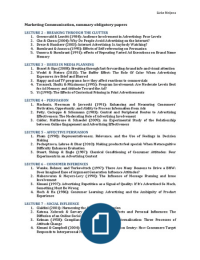Lieke
Neijens
Marketing
Communication,
summary
obligatory
papers
LECTURE
2
–
BREAKING
THROUGH
THE
CLUTTER
1. Greenwald
&
Leavitt
(1984):
Audience
Involvement
in
Advertising:
Four
Levels
2. Cho
&
Cheon
(2004):
Why
Do
People
Avoid
Advertising
on
the
Internet?
3. Dreze
&
Hussherr
(2003):
Internet
Advertising:
Is
Anybody
Watching?
4. Burnkrant
&
Annuva
(1995):
Effects
of
Self-‐referencing
on
Persuasion
5. Unnuva
&
Burnkrant
(1991):
effects
of
Repeating
Varied
Ad
Executions
on
Brand
Name
Memory
LECTURE
3
–
ISSUES
IN
MEDIA
PLANNING
1. Brasel
&
Gips
(2008):
Breaking
through
fast-‐forwarding:
brand
info
and
visual
attention
2. Wedel
&
Pieters
(2015):
The
Buffer
Effect:
The
Role
Of
Color
When
Advertising
Exposures
Are
Brief
and
Blurred
3. Happy
and
sad
TV
programs:
how
they
affect
reactions
to
commercials
4. Tavassoli,
Shultz
&
Fitzsimons
(1995):
Program
Involvement:
Are
Moderate
Levels
Best
for
Ad
Memory
and
Attitude
Toward
the
Ad?
5. Yi
(1990):
The
Effects
of
Contextual
Priming
in
Print
Advertisements
LECTURE
4
–
PERSUASION
1. MacInnis,
Moorman
&
Jaworski
(1991):
Enhancing
and
Measuring
Consumers’
Motivation,
Opportunity,
and
Ability
to
Process
Information
from
Ads
2. Petty,
Cacioppo
&
Schumann
(1983):
Central
and
Peripheral
Routes
to
Advertising
Effectiveness:
The
Moderating
Role
of
Advertising
Involvement
3. Calder,
Malthouse
&
Schaedel
(2009):
An
Experimental
Study
of
the
Relationship
between
Online
Engagement
and
Advertising
Effectiveness
LECTURE
5
–
AFFECTIVE
PERSUASION
1. Pham
(1998):
Representativeness,
Relevance,
and
the
Use
of
Feelings
in
Decision
Making
2. Pocheptsova,
Labroo
&
Dhar
(2010):
Making
products
feel
special:
When
Metacognitive
Difficulty
Enhances
Evaluation
3. Stuart,
Shimp
&
Engle
(1987):
Classical
Conditioning
of
Consumer
Attitudes:
Four
Experiments
in
an
Advertising
Context
LECTURE
6
–
CONSUMER
INFERENCES
1. Wanke,
Bohner,
and
Turkowitsch
(1997):
There
Are
Many
Reasons
to
Drive
a
BMW:
Does
Imagined
Ease
of
Argument
Generation
Influence
Attitudes?
2. Maheswaran
&
Meyers-‐Levy
(1990):
The
Influence
of
Message
Framing
and
Issue
Involvement
3. Kimani
(1997):
Advertising
Repetition
as
a
Signal
of
Quality:
If
It’s
Advertised
So
Much,
Something
Must
Be
Wrong
4. Hoch
&
Ha
(1986):
Consumer
Learning:
Advertising
and
the
Ambiguity
of
Product
Experience
LECTURE
7
–
SOCIAL
INFLUENCE
1. Cialdini
(2001):
Harnessing
the
Science
of
Persuasion
2. Katona,
Xubcsek
&
Sarvary
(2011):
Network
Effects
and
Personal
Influences:
The
Diffusion
of
an
Online
Social
Network
3. Kelman
(1958):
Compliance,
Identification,
and
Internalization:
Three
Processes
of
Attitude
Change
4. Kimani
&
Campbell
(2004):
Goal
Seeker
and
Persuasion
Sentry:
How
Consumers
Target
Responds
to
Interpersonal
Marketing
Persuasion
, Lieke
Neijens
Lecture
2,
paper
1
Greenwald
&
Leavitt
(1984):
Audience
Involvement
in
Advertising:
Four
Levels
Abstract
–
the
effectiveness
of
advertising
messages
is
widely
believed
to
be
moderated
by
audience
involvement.
In
this
paper,
psychological
theories
of
attention
and
levels
of
processing
are
used
to
establish
a
framework
than
can
accommodate
the
major
consumer
behavior
theories
of
audience
involvement.
Four
levels
of
involvement
are
identified
(in
order
from
low
to
high)
as
pre-‐attention,
focal
attention,
comprehension,
and
elaboration.
These
levels
allocate
increasing
attention
capacity
to
a
message
source,
as
needed
for
analysis
of
the
message
by
increasingly
abstract
(and
qualitatively
distinct)
representational
systems.
Lower
levels
use
relatively
little
capacity
and
extract
information
needed
to
determine
whether
higher
levels
will
be
invoked.
The
higher
levels
require
greater
capacity
and
result
in
increasingly
durable
cognitive
and
attitudinal
effects.
Concepts
Audience
involvement
refers
to
the
number
of
conscious
bridging
experiences,
connections,
or
personal
references
per
minute
that
the
viewer
makes
between
his
own
life
and
the
stimulus.
It
is
the
allocation
of
attentional
capacity
to
a
message
source,
as
needed
to
analyze
the
message
at
one
of
a
series
of
increasingly
abstract
representational
levels.
Four
levels
of
attention
(from
low
to
high:
levels
of
cognitive
activity
that
(1)
require
increasing
amounts
of
attentional
capacity,
and
(2)
produce
increasingly
durable
effects
on
memory).
1. Pre-‐attention
–
little
capacity
required
for
feature
representation.
Stimuli
receive
extensive
immediate
analysis
that
produces
no
lasting
effect.
2. Focal
attention
–
modest
capacity
required
to
focus
on
one
message
source,
and
to
translate
the
message’s
sensory
content
into
categorical
codes
(object,
name,
word).
3. Comprehension
–
further
capacity
is
required
for
analyzing
and
establishing
traces
by
constructing
a
propositional
representation
of
it.
4. Elaboration
–
full
capacity
is
required
to
integrate
message
content
with
existing
conceptual
knowledge
(conceptual
analysis).
It
produces
substantial
freedom
of
memory
and
attitude
from
the
specific
details
of
the
original
message
or
setting.
Arousal
refers
to
a
state
of
wakefulness,
general
preparation,
or
excitement
that
facilitates
the
performance
of
well-‐learned
responses.
Capacity
is
a
limited
resource
that
is
used
to
focus
on
a
specific
task
and
that
is
needed
in
increasing
amounts
as
the
cognitive
complexity
of
a
task
increases.
An
orienting
response
consists
of
mild
psychological
arousal
together
with
physical
orientation
of
receptors
toward
the
source
of
stimulation.
The
orienting
response
corresponds
to
focal
attention
being
directed
toward
the
novel
stimuli.
Selective
listening
commands
focal
attention
and
also
effectively
prevents
focusing
on
any
concurrent
auditory
message.
The
cognitive
demands
of
repeating
one
message
and
rejecting
a
second
may
use
enough
capacity
to
prevent
the
subject’s
involvement
in
the
attended
message
from
progressing
to
any
level
of
involvement
higher
than
focal
attention.
Findings
Under
high-‐involvement,
a
communication
should
act
most
directly
to
modify
beliefs
(that
is,
verbalize
propositions).
High
involvement
products
tend
to
have
more
salient
distinguishing
attributes.





